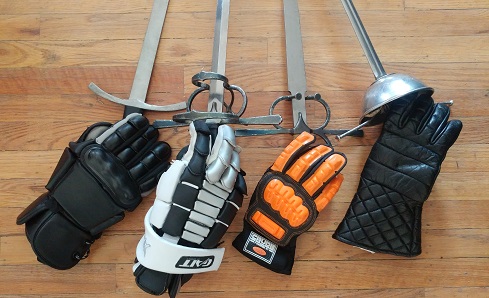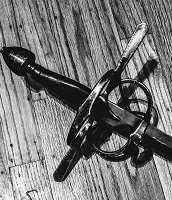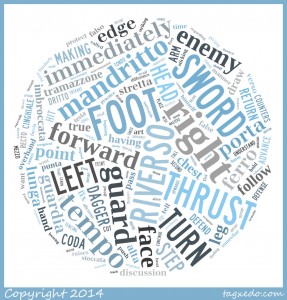Gloves come up fairly regularly in every HEMA Facebook group I pay attention to. It’s especially bad for those of us doing sidesword, because we need nearly as much protection as the longsword folks, and have to put them in a hilt nearly as complex as the rapier folks. Well, I’m not going to tell you what gloves to get for sidesword (I don’t really have this entirely solved myself), but just think that these facts should at least be relevant to your decision-making process on gloves.
- If you are cutting with proper body mechanics, your sidesword can hit almost as hard as a longsword.
- Hands are remarkably delicate, with many small bones.
- People’s tolerance for injury varies considerably – one person may think a few broken bones now and then are fine, another may find this unacceptable.
- The impact a broken finger has on your life may vary considerably (one of my training partners, after two surgeries, a pin in his pinkie, and two years of recovery, still can’t fully grip a sidesword; other people get a minor fracture and are mostly recovered in a 3 – 4 weeks).
- Plain leather gloves do very very little to protect against high-intensity shots from a sidesword.
- Your hand is the easiest target for your opponent, and many historical masters direct their students to attack the hand.
- Some people say “if you can’t defend your hands you should be drilling, not doing freeplay”, but there is nothing magical about freeplay – high intensity drilling, that includes teaching you to protect your hands, will include moments where you get hit in the hands, and those hits count too.
- No one can drill to the point where they guarantee no hits to their hands – the only way to accomplish that is to make sure you never fence anyone better than yourself.
- Fencing people who are better than yourself is one of the keys to growing as a martial artist.
- In general, the more protective a glove is, the more it interferes with technique.
- Wrist cuts (tramazzone in the Bolognese systems) are fundamental to most sidesword use, and often very hard or impossible to do with heavy gloves on.
- A video of a glove showing high mobility may mean nothing. The guy in the video is wearing that glove with just a t-shirt and the wrist mobility is great, but when you wear it with forearm protectors your wrist can’t move; the glove fits in the guard great for the guy in the video, but you can’t get it into your guard at all. Videos and testimony are fine, but not a guarantee that you will have the same results.
- Every glove is a compromise between protection and mobility.
- You can use lighter gloves with higher intensity by having the hilt do more of the protective work – using a schiavona with light gloves allows for higher intensity than using an arming sword with light gloves, for example. However, this is still a compromise – the additional weight and size in the hilt makes the sword handle differently than a simpler hilt. (HT to the excellent Richard Cullinan for this point.)
- There is no right answer on the compromise – you have to decide, for your context, what makes sense.
- Don’t expect the wrong results from your compromise – if you favor protection, understand that your technique will suffer; if you favor mobility, you accept higher risk of injury.
- It’s perfectly legitimate to have different gloves for different purposes. Just remember which gloves you’re wearing and operate according to the compromise that they represent.
- Going slow and/or limiting shots to the hands is a compromise in technique just as much as wearing super-protective gloves that prevent certain techniques.
- Gloves are only one part of keeping your hands safe – the control of your partner is another component. Control and gloves are not interchangeable – neither one protects you from what the other one does. You can go without gloves with low intensity and extremely high control; there is no level of glove that will keep you safe without control, however.
- Everyone offering advice is doing it from the compromises they are willing to accept, based on their values. The most helpful advice acknowledges what is given up if you follow their recommendation; the worst advice pretends like their solution doesn’t make you compromise anything.
- Good luck.


